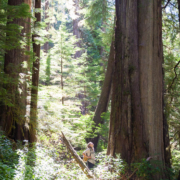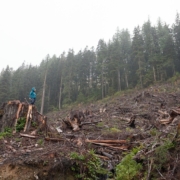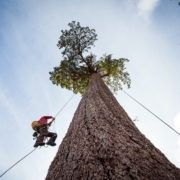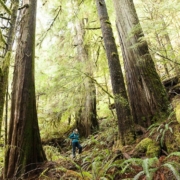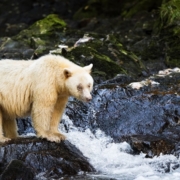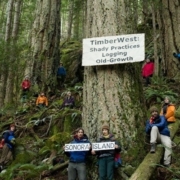Canada’s Two Grandest Old-Growth Forests Under Logging Threat by the Teal-Jones Group!
Port Renfrew – Surrey-based forestry company, the Teal-Jones Group, is aggressively moving forward with plans to log and build roads into Canada’s two most magnificent old-growth forests, the Central Walbran Ancient Forest (about 500 hectares) and the Edinburgh Mountain Ancient Forest (about 1500 hectares) on southern Vancouver Island. The company is planning eight new cutblocks (clearcuts) and a new road in the Central Walbran, and two new cutblocks and a new road on Edinburgh Mountain. The Walbran Valley is home to perhaps Canada’s finest stand of old-growth redcedars, the Castle Grove, while Edinburgh Mountain is where “Big Lonely Doug” (discovered last year by Ancient Forest Alliance activists to be Canada’s 2nd largest Douglas-fir tree – alas, completely surrounded by a 2012 clearcut) still stands and where the threatened “Christy Clark Grove” (ie. Lower Edinburgh Grove) is located in the Gordon River Valley. Maclean’s Magazine recently featured the Ancient Forest Alliance’s video of tree-climbers at Edinburgh Mountain scaling Big Lonely Doug among a series of videos featuring “Canada’s greatest people, places, and experiences”
- See VIDEO footage on the Central Walbran Ancient Forest at https://youtu.be/vNGGsg3I3ngand Walbran photos at https://16.52.162.165/photos-media/walbran-overview/; a recent ARTICLE at https://www.timescolonist.com/news/local/old-growth-logging-in-walbran-could-trigger-protests-group/>1.1962233; and a MAP at https://www.wildernesscommittee.org/sites/all/files/CentralWalbran_Map_June2015_0.pdf
- See PHOTOS of a section the Edinburgh Mountain Ancient Forest at https://16.52.162.165/photos.php?gID=16; the original VIDEO of Big Lonely Doug and Edinburgh Grove at https://www.youtube.com/watch?v=E7LFM9EFKLc; the full tree-climbing VIDEO of Big Lonely Doug at https://www.youtube.com/watch?v=OxPlKVK8RLM.
- See maps and stats on the remaining old-growth forests on BC’s southern coast at: https://16.52.162.165/old-growth-maps.php
(***NOTE: News media are free to run any video footage and photos, credit to “TJ Watt” where possible. Contact us if you need higher res video or photos)
Conservationists are escalating pressure on the BC government and the company through a public awareness campaign of hikes, expeditions, protests, and letter-writing drives, calling on the company to back off and the BC government to protect the two ancient forests. Teal-Jones Group is a Surrey-based company that logs and sells endangered old-growth forests – including ancient redcedar trees – for pulp, paper, and solid wood products.
Both the Central Walbran Valley and Edinburgh Mountain are just a few kilometers from the world-famous West Coast Trail of Pacific Rim National Park Reserve. Both areas are home to Canada’s most magnificent old-growth temperate rainforests of giant western redcedar, Douglas-fir, Sitka spruce, and hemlock trees. Species at risk include Queen Charlotte Goshawks, marbled murrelets, screech owls, and red-legged frogs in the forest, while coho salmon and steelhead trout spawn in the rivers. The areas are popular for recreationalists, including hikers, campers, anglers, hunters, and mushroom pickers, and are located on public (Crown) lands in Tree Farm Licence 46 near Port Renfrew in Pacheedaht Nuu-cha-Nulth territory.
The Ancient Forest Alliance is calling on the BC government to protect these areas from logging through expanded Old-Growth Management Areas (OGMA’s), core Wildlife Habitat Areas (WHA’s), Land Use Orders (LUO’s), and/or through a proposed new “legal tool” to protect BC’s biggest trees and grandest groves, which the Ministry of Forests, Lands, and Natural Resource Operations is currently developing. The organization is also calling on the BC government to implement a comprehensive science-based plan to protect all of BC’s remaining endangered old-growth forests, and to also ensure a sustainable, value-added second-growth forest industry.
“Teal-Jones seems to be committing to a War in the Woods by aggressively moving forward to log southern Vancouver Island’s most contentious ancient forests. The Walbran Valley was the birthplace of the ancient forest protest movement in Victoria decades ago. Logging there has repeatedly triggered protests, beginning in 1991 and flaring up regularly for more than a decade thereafter. Thousands of British Columbians love the ancient forests of the Castle Grove, Emerald Pool, Bridge Camp, Summer Crossing, and Fletcher Falls in the Central Walbran Valley,” stated Ken Wu, Ancient Forest Alliance executive director. “Similarly, the Gordon River Valley region where the threatened Edinburgh Mountain Ancient Forest is located has been in the international spotlight because of the nearby Avatar Grove, a popular, now-protected ancient forest just across the valley, and Big Lonely Doug, Canada’s 2nd largest Douglas-fir, which towers by itself in a now-destroyed part of the Edinburgh Mountain Ancient Forest. Both the province and the company will be held accountable for what happens in these areas.”
“Because of the ideal growing conditions in the region, Canada’s temperate rainforests reach their most magnificent proportions in the Walbran, Carmanah, and Gordon River Valleys. They’re Canada’s version of the American redwoods. Given this fact – and that virtually all of the unprotected ancient forests are either clearcut or fragmented by logging today on southern Vancouver Island – it should be a no-brainer that the two largest, contiguous tracts here, the Central Walbran and Edinburgh Mountain, should be immediately protected”, stated TJ Watt, Ancient Forest Alliance campaigner and photographer.
Of the eight cutblocks that Teal-Jones is proposing to log in the Central Walbran Valley, the company recently applied on June 23 to the Forest Service to start logging one of them near the Upper Castle Grove, Cutblock 4424. Whether the Ministry of Forests, Lands, and Natural Resource Operations grants the permit is to be seen. The Castle Grove is perhaps the most extensive stand of densely-packed monumental old-growth redcedars in Canada, and possibly the world.
At the same time, the company is planning a new logging road and two cutblocks in the Edinburgh Mountain Ancient Forest, just a few kilometers away from the Walbran Valley. The old-growth forests of Edinburgh Mountain are significantly more extensive than those of the Central Walbran Valley, making it the largest, primarily intact tract of unprotected old-growth forest left on southern Vancouver Island (south of Bamfield). The proposed new road by Teal-Jones would pierce hundreds of metres into the heart of the Edinburgh Mountain Ancient Forest and would even traverse an Old-Growth Management Area (OGMA).
The Edinburgh Grove, the most spectacular part of the Edinburgh Mountain Ancient Forest on its southwestern side, has also been nicknamed the “Christy Clark Grove” after British Columbia’s premier as a strategy to put her on the spot and in the spotlight to protect it. More than half of the Edinburgh Mountain Ancient Forest is open for logging, while other parts are protected as a “core” Wildlife Habitat Area (the “buffer” zone can still be logged, and has already been logged in several areas) for the endangered Queen Charlotte Goshawk, as an Ungulate Winter Range, and as Old-Growth Management Areas. See an original article about the Christy Clark Grove at https://www.canada.com/story.html?id=5d72d50a-b7b7-4787-b772-323929e0d98cCanada’s 2nd largest Douglas-fir tree, “Big Lonely Doug”, was once part of the Edinburgh Grove until its surrounding neighbours were clearcut in a 2012 cutblock – see https://www.theglobeandmail.com/news/british-columbia/canadas-loneliest-tree-around-1000-years-old-still-waiting-on-help/article19064507/.
The Central Walbran’s old-growth western redcedar, Sitka spruce, and hemlock forests have long been proposed for protection by the environmental movement since the early 1990’s, when the valley was “ground zero” for protests by southern Vancouver Island’s environmental movement. The early Walbran protests played an important role in supporting the build-up towards the massive Clayoquot Sound protests near Tofino on Vancouver Island in 1993.
The Castle Grove is considered by many conservationists as the finest, unprotected stand of monumental old-growth western redcedar trees in Canada. It includes a flat section (Lower Castle Grove), currently without any logging plans, and an adjacent mountainside (Upper Castle Grove) that is now under direct threat by Teal-Jones. Teal-Jones had flagged part of the Upper Castle Grove for logging in the 2012, but after a public campaign by the Ancient Forest Alliance, the Ministry of Forests reported later than year that the company was not intending to log there – unfortunately, since then, the company is now proposing to place three clearcuts in the Upper Castle Grove. See the video and the media releases from 2012: https://www.youtube.com/>watch?v=lHnG_sC4oms and https://16.52.162.165/news-item.php?ID=515
A portion of the Edinburgh Mountain Ancient Forest was perhaps the most spectacular old-growth redcedar grove in the world, more densely packed with a greater number of monumental ancient redcedars (13 to 16 feet wide) than perhaps any other cedar grove – until it was clearcut in 2010. The logging of this grove triggered a Forest Practices Board investigation that recommended that the province undertake a new legal tool to protect the province’s biggest trees and grandest groves – which the province is still in the process of developing.
Old-growth forests are vital to sustain endangered species, climate stability, tourism, clean water, wild salmon, and the cultures of many First Nations.
On BC’s southern coast, satellite photos show that at least 75% of the original,productive old-growth forests have been logged, including well over 90% of the valley bottoms where the largest trees grow.
MORE BACKGROUND INFOThe Walbran Valley is about 13,000 hectares in size, with about 5500 hectares of the Lower Walbran Valley protected within the Carmanah-Walbran Provincial Park and about 7500 hectares of the Upper Walbran Valley remaining unprotected. The unprotected Upper Walbran Valley is divided into two “Tree Farm Licences” (TFL’s): TFL 46, held by Teal Jones, and TFL 44, held by Western Forest Products, on Crown lands in the unceded territory of the Pacheedaht Nuu-Cha-Nulth people.
While most of the Upper Walbran Valley has been heavily fragmented by old-growth logging, two major tracts of ancient forest remain largely unlogged there: The Castle Grove (Canada’s finest ancient redcedar forest) and the greater Central Walbran Ancient Forest (currently under potential logging threat) which abuts against the boundary Carmanah/Walbran Provincial Park, spanning about 500 hectares in extent.
While small sections of the Central Walbran Ancient Forest are protected within Riparian Reserves, an Ungulate Winter Range, and Old-Growth Management Areas, the vast majority of the area is open for logging. The Central Walbran Ancient Forest is a popular and heavily used area by recreationalists, where the main boardwalk trails for hiking, riverside camping area, Emerald Pool swimming area, and the spectacular Fletcher Falls are found.
The Central Walbran Ancient Forest, Castle Grove, and adjacent unprotected forests were designated as a “Special Management Zone” (SMZ) by the BC government in 1994. The SMZ is supposed to be managed to maintain its environmental and biodiversity values – however, numerous destructive clearcuts have tattered much of the SMZ over the past 20 years.
Edinburgh Mountain includes about 1500 hectares of intact ancient forest, none of which are included in legislated protected areas. About 60% or more of its ancient forests are open for logging, while about 40% are in forest reserves which prohibit logging (ie. within Old-Growth Management Areas and an Ungulate Winter Range). In addition, all of the Grove is included within a 2100 hectare Wildlife Habitat Area, which still legally allows clearcut logging in almost 90% of the designation itself (ie. in the “buffer”, not the small “core” area). In 2010 and 2012 some of the very largest trees in Canada – some 13 to 16 feet in diameter – were logged within the Wildlife Habitat Area on Edinburgh Mountain. The Lower Edinburgh Grove on its southwestern side has some high concentrations of giant Douglas-firs and western redcedars. The grove once included “Big Lonely Doug”, Canada’s 2nd largest Douglas-fir tree, until the forests surrounding the tree were logged in 2012, and while it still includes the “Gnarly Clark”, a massive redcedar with some giant burls, “General Clark”, a huge, straight redcedar, and the “Clark Giant”, a near record-size Douglas-fir that, at over 30 feet in circumference! The Clark Giant is currently in a forest reserve that is off-limits to logging, but stands close to an area that could be clearcut.
In order to placate public fears about the loss of BC’s endangered old-growth forests, the BC government’s PR-spin typically over-inflates the amount of remaining old-growth forests by including hundreds of thousands of hectares of marginal, low productivity forests growing in bogs and at high elevations with smaller, stunted trees, lumped in with the productive old-growth forests, where the large trees grow (and where most logging takes place). “It’s like including your Monopoly money with your real money and then claiming to be a millionaire, so why curtail spending?” stated the Ancient Forest Alliance’s Ken Wu.
War in the Woods II ?
In 1991, Western Canada Wilderness Committee (WC2) campaigner, Torrance Coste, was a three-year-old growing up in Lake Cowichan. Barrelling through his community at the time were logging truck loads of old-growth logs coming out of the Walbran Valley and buses of protestors coming in. “I even remember the hand-painted signs: ‘No raw log exports’ which I could just about read.” Coste adds, “Though I didn’t have a clue what they meant then, I do now.”
On one of the buses of protestors was Ken Wu, a 17-year-old first-year biology student at UBC, fresh from the prairies and new to activism. Ken was dropped into a grove of old-growth western red cedar and spruce and, according to Wu, “I lost my ecovirginity.” He returned to UBC and organized his first rally to save the old growth of Walbran. One hundred people turned up and he has continued organizing ever since, first as a campaigner for WC2 and then under his own banner of the Ancient Forest Alliance.
After years of protest in the late 1980s and early 1990s, the BC government bowed to public pressure and created Carmanah Walbran Provincial Park by purchasing back Tree Farm Licences from MacMillan Bloedel for $83.75 million. But not all the valley’s forests were saved.
Now the Walbran is poised once again to become ground zero for the latest “war in the woods”—civil disobedience in the form of peaceful blockades of logging. Environmentalists are condemning the plans of Teal Jones Group—a logging company that has held Tree Farm Licence 46 since 2004—to log in the Central Walbran Ancient Forest. The eight cutblocks proposed are in the controversial “bite” out of Carmanah Walbran Provincial Park—literally a big chunk of very high value western red cedar groves left outside the park when the boundary was drawn. The cutblocks are near hiking trails that lead to massive old trees, including the 1000-year-old Castle Giant, more than five metres across at its base. The BC government has approved Teal Jones’ Forest Stewardship Plan, although it has yet to receive plans or issue permits for the cutting.
Coste believes that if it hadn’t been for early campaigners, nothing of the Carmanah/Walbran forests would have been saved for his generation. So he asked himself what his generation is going to save for the next. “We are going to revive the war in the woods. Every time there has been a presence, changes are made. There is a willingness to make the Walbran this year’s Burnaby Mountain. Of course,” he adds, “we would prefer to see this resolved by government action rather than blocking roads.”
The Sierra Club of BC is also wading in, brandishing facts and figures. In 2004, the Sierra Club produced a map of what was left of productive old growth temperate rainforest on Vancouver Island. A decade ago, 90 percent of the valley bottom forests, where the biggest trees were, had already gone. Not surprisingly, things have only become worse in the last decade. It is a finite resource. Jens Wieting, forest campaigner for Sierra Club, who has also been on this file for most of his professional career, says his frustration comes in a variety of forms. Although new conservation-oriented economic tools exist in BC, such as those being implemented in the Great Bear Rainforest which allow for 70 percent protection of the landscape, no such effort at conservation is happening on Vancouver Island. “Ten percent protection of these temperate rainforests, which have the highest sequestration rates of carbon in the world, is not enough,” notes Wieting.
The old Vancouver Island Land Use Plan, which was never properly implemented, hasn’t been updated for two decades. After being eaten away by industry, bit by bit, only 10 percent of the entire land base has been set aside in a fragmented collection of parks, Old Growth Management Areas, Wildlife Habitat Areas, and Wildlife Tree Patches. The latter, referred to as WTPs, are a specific designation protecting “a group of trees that are identified in an operational plan to provide present or future wildlife habitat.” Retention requirements in any cutblock are regulated at 10 percent. Typically these WTPs are less than two hectares wide and are frequently subjected to blowdown, yet WTPs are about the only tool being used by Teal Jones. These old designations have resulted in a patchy landscape that doesn’t serve wildlife or forest health.
The relationship between preserving carbon sinks and mitigating climate change is the other big factor missing in current government policy on Vancouver Island. A report released last year by the Sierra Club—Carbon at Risk: BC’s Unprotected Old-growth Rainforest—called for the elimination of old-growth logging on Vancouver Island. It showed that one year of logging old-growth rainforest in southwest BC was responsible for releasing approximately three million tonnes of carbon dioxide into the atmosphere. As Wieting pointed out, “We blew BC’s entire carbon savings for a year because the BC government doesn’t have a plan to protect the rare old-growth forests of Vancouver Island and the South Coast.”
This year appears to be no exception. So long as we continue to log at the same pace on Vancouver Island, we nullify any progress on reducing provincial carbon emissions.
INSPIRED BY HIS LOVE of the ancient forest near his hometown, Torrance Coste represents the next generation of activists: well versed in biodiversity, carbon science, economic analysis, and endangered species legislation.
Many endangered species inhabit these forests, including Northern Goshawk laingi subspecies, Marbled Murrelet, Western Screech Owl kennicottii subspecies—all of which Coste says he discussed with Teal Jones representatives over the last nine months. “I guess I was naïve. I thought that they were listening to us when we asked them to at least stay out of the bite, which is only 486 hectares or 0.5 percent of their total 99,130-hectare TFL.”
Teal Jones did a “surprise” clearcut in this “bite” in 2013, an act which put ENGOs on high alert and running to company offices to discuss the situation. “When we recently got the plans for the eight cutblocks in the bite and found orange flagging tape near the famous Castle Grove, after all our conversations, we knew there was no sense in talking anymore,” Coste says. (Focus requested an interview with Teal Jones officials, but the company didn’t respond. The company website notes it complies with a Canadian Standard Association Sustainable Forest Management certification, a low bar over which the company can easily step and then claim it complies with existing government rules and policy.)
Neither Coste nor Wu were old enough to be involved in the extensive negotiations and planning in the ’90s that resulted in British Columbia leading the world by being the first to sign the landmark 1992 Earth Summit Conventions on Biodiversity, Climate Change and Desertification. The 1991 Walbran protests led to the setting up of the Wilderness Advisory Committee, the Old Growth Strategy, the Protected Areas Strategy, the Clayoquot decisions, and the Commission on Resources and Environment, which in turn led to the Vancouver Island Land Use Plan (VILUP) in 1994.
Few young activists today can believe BC was once a world leader in forest ecology, biodiversity, climate change, and best practices for public consultation. What they see now is a bare-bones lip-service approach, the result of a gutted Forest and Range Practices Act. “Professional reliance”—whereby forestry companies have been given much of the responsibility for oversight previously conducted by government officials—and pseudo consultation have become the operating principles by which Crown forests are managed.
Masters student Sabrina Schwartz at the University of Alberta reviewed the 20-year-old VILUP in 2014 regarding its “ability to cope with past, current and future demands of its stakeholders.” She concluded: “The VILUP was a necessary government tool, to solve the intense conflicts of the ‘War in the Woods’ and to clarify the general land use management on Vancouver Island; it was, however, not able to establish a province-wide sustainability guideline, which would have left an organized, focused and fair land use and resource management on Vancouver Island.”
In less diplomatic words, the disorganized, scattered and uneven policy of the BC government is laying the province wide open to a future “war in the woods.” The BC government responded to Focus’ questions with the statement that Teal Jones is within its legal rights to log in the area. It failed to respond to questions about the role of forests in its climate action plan.
Coste is quickly finding out “you have to get out there and protest to get them to listen. Grass roots pressure has worked in the past. It is going to work again.” Coste’s sights are on the Walbran—his home patch. For Wu, “these cutblocks are the cherries on the cake, we still have to address the cake. We need a new land use plan for Vancouver Island.” For Wieting, that is a plan that is province-wide and integrates biodiversity, diversification of economic opportunities, and climate change.
(In late June, shortly after Focus went to press with this story, Teal Jones submitted an application to the Province to log one of the eight cutblocks.)
AFA’s "Climbing Big Lonely Doug" video on Maclean’s "Canada148"
Maclean’s magazine has featured the Ancient Forest Alliance’s video on climbing “Big Lonely Doug”, discovered in 2014 by AFA campaigners to be the 2nd largest Douglas-fir tree in Canada – but standing alone since 2012 when Teal-Jones clearcut all the ancient trees around Big Lonely Doug. Our video is one of the 148 videos of Canada’s most incredible people, places and experiences, to celebrate Canada’s 148th birthday.
Walbran Valley war
Here is a Global TV piece on proposed logging in the Central Walbran Valley by Teal-Jones, a Surrey-based company threatening endangered old-growth forests in several areas:
https://globalnews.ca/news/2042889/protests-will-follow-any-old-growth-logging-group/
A Conservation Review of the Elphinstone Provincial Park Expansion Proposal
Wayne McCrory – one of Canada’s leading conservation-biologists, has completed an ecological inventory of the 2,000Ha lower Elphinstone forests that is the subject of a park expansion & protection area. Learn about the unique features of this lower elevation, emerging old-growth forest… see intro and link below…
Elphinstone Conservation Review June 2015 (McCrory Wildlife Services) **VIEW via link at: https://www.loggingfocus.org/2015-research-reports/
INTRO and Background – Hans Penner
June 10, 2015, Public Meeting, Roberts Creek Hall
A CONSERVATION REVIEW OF THE ELPHINSTONE PROVINCIAL PARK EXPANSION PROPOSAL
Good evening and welcome to everyone here tonight.
We wish to acknowledge, with gratitude, that we are meeting on Sechelt First Nation Traditional Territory and that the study area of the Conservation Review is located on Sechelt and Squamish First Nations Traditional Territories.
The study area is located above the residential areas of Roberts Creek between the Town of Gibsons and the District of Sechelt. The 1500ha area was identified as an environmentally important site in The Land for Nature Project initiated in 1995. The 1500ha Park / Protected area proposal is included in the recently adopted Roberts Creek Official Community Plan. The area is also identified as a Community Interface Zone by the Ministry of Forests.
Logging activity in the 1500ha area has been very controversial. In 2012, the logging of block A87124, by the old Wagon Fest Trail, by BC Timber Sales (BCTS) and blocks EW 001 and EW 002, the Wilson Creek Forest, by the Sunshine Coast Community Forest (SCCF) resulted in a number of roadblocks, injunctions and finally in over a dozen arrests.
In June 2013 we first discussed the idea of a scientific study of the 1500ha Elphinstone Forest with BC Timber Sales and in July of that year we made a presentation to the SCRD Board with a request to support this study in order to have future decisions regarding this area based on sound scientific knowledge and community participation. At their July 25, 2013 meeting the SCRD Board passed resolution, 357/13, as follows:
“That the concept of a scientific study of the 1500ha of the Elphinstone Forest be supported in principle and that support be conveyed to the Provincial Government”.
In a letter to the Minister of Forests and the Minister of Environment the SCRD asked the Ministers to “advise their staff to initiate a discussion with our community and Regional District staff to explore how a study would proceed”. We still haven’t heard back from them!
In the fall of 2014 funding became available from a generous donor and we decided to proceed with the study. We were fortunate to make contact with Wayne McCrory and he agreed to do a Conservation Review of the area. Wayne conducted field studies, compiled and analysed existing data and has now completed a break-through report on our Elphinstone forest. He makes a compelling case for protection of this unique area.
Read more: https://www.loggingfocus.org/2015-research-reports/
AFA Office Hour Update
Thank You to the Mountain Equipment Co-op (MEC)!
The Ancient Forest Alliance is most grateful to the Mountain Equipment Co-op (MEC) for their major support provided through their Community Contributions grant program. This funding support will allow the AFA to fully complete the Avatar Grove Boardwalk as a model for sustainable eco-tourism promoting old-growth forest conservation. See MEC's website at: www.MEC.ca
Logging company takes heat for cutting old growth trees in the Great Bear Rainforest
Environmentalists condemned TimberWest's cutting of old growth trees in the Great Bear Rainforest, one of the largest remaining temperate rainforests in the world.
Spanning 64,000 square kilometres along British Columbia’s Central and North Pacific Coast, the Great Bear Rainforest is the home to a rich ecosystem of whales, eagles, and the rare “spirit bear” — a white bear found nowhere else on the planet and revered by the Kitasoo, Heiltsuk and Gitxaala First Nations.
“We already have a serious deficit of old growth forests in B.C., and it's very concerning that TimberWest has increased logging in the last five years,” said Sierra Club BC forest and climate campaigner Jens Wieting. The company logged 248,188 cubic metres of timber within the Great Bear Rainforest in 2009, and 778,580 in 2011.
Although TimberWest states that it is logging well within the agreed limits, forest conservationists argue the company has been targeting a vulnerable part of the rainforest at a time when sensitive negotiations to protect old growth forest are underway.
“TimberWest targeted the most endangered ecosystems while the Great Bear Rainforest negotiations have been underway,” said ForestEthics Solutions BC Forest Campaigns Director Valerie Langer.
Langer, who was on the forefront of campaigns that forced companies to limit logging in the northern rainforest, said the logging has been detrimental to the negotiations.
“It means TimberWest undermined proposed Restoration Zones that form part of the ecosystem-based management (EBM) proposal currently near completion,” she said.
The Great Bear Rainforest is at the centre of 19 years of negotiations between the province, First Nations, environmentalists and industry. If finalized, 70 per cent of old growth trees in the area will be protected—which is the threshold scientists say is necessary for the rich ecosystem to remain intact.
TimberWest chief forester and sustainability VP Domenico Iannidinardo defended the company's logging activities, saying it was committed to preserving the old growth trees in the Great Bear Rainforest.
“We've been a participant in the Great Bear Rainforest negotiations since 1996,” he said. “We've met all the requirements of sustainable harvest levels and we'll continue to do so.”
Iannidiarno said if the Great Bear Rainforest agreement is finalized, the company will have to reduce its harvest levels. He said the company was prepared to “evolve” with the times, and that it was a significant employer in remote areas of northern B.C., providing jobs to First Nations as well.
Wieting said conservation of the Great Bear Rainforest — home to grizzly bears, salmon, wolves, and birds such as the marbled murrulet and eagle — is critically important. He said if the agreement to protect 70 per cent of old growth forest in the Great Bear Rainforest is finalized, it will be an example of conservation for the rest of the world.
“This is what the world is desperately looking for — solutions that allow economic activity without undermining the environment. We're getting very close.”
He said for the agreement to be truly successful, the B.C. government will need to implement a monitoring system to ensure that logging agreements are not violated.
“There have been millions of cubic metres of over cutting in B.C. forests. The government gives companies a massive amount of flexibility with very little oversight. We will need more checks and balances to ensure the trees are protected.”
Return to Sonora: TimberWest in the Great Bear Rainforest
It was exactly 2 years ago today that I published a blog on Sonora Island – the southernmost end of the Great Bear Rainforest, within the traditional territories of Kwakwaka’wakw and Coast Salish peoples. In that blog I described the struggle the local community and environmental organizations have had to improve the logging practices of TimberWest Forest Corporation – especially their curious methods of identifying old-growth forests on the ground. I wrote that this was of particular concern as this is a region where less than 5% of many forest ecosystems remains in old growth conditions, and where the majority of ecosystems are globally endangered.
Since that original blogpost there has been good news and bad news.
First the good news: TimberWest agreed to a temporary harvest moratorium on six contentious forest blocks that I described previously in that blog, while it undertook to redefine old-growth and develop reserve designs to set aside rare old growth ecosystems. It worked closely with the local community and that is great. Peachy.
Now the bad news. That temporary moratorium on the six contentious blocks is just that temporary. And, it only constitutes a mere 0.2% of the total area of TimberWest’s tenure (in its Tree Farm License 47).
And now the really bad news. Recent analysis shows that as we move towards implementing stricter logging regulations in 2015, TimberWest has dramatically accelerated its rate of logging in the southern Great Bear Rainforest part of its tree farm license over the past five years. They have logged over one million cubic metres more (the equivalent of a million telephone poles) than they have been allocated as an average Annual Allowable Cut in the five year period (from 2010 to 2014). The company has logged more than 4,400 hectares of rainforest in this area since 2009, 11 times the area of Vancouver’s Stanley Park. This is particularly concerning given that TimberWest does not currently have a plan to reserve and restore these endangered ecosystems and the species that depend on them. Indeed, in the past 5 years, more than 50% of TimberWest’s logging has occurred in areas that were identified five years ago as priorities for landscape reserves. Not only is this not consistent with the spirit and intent of Ecosystem-Based Management (and is also contrary to what their senior executive team committed to us in a 2011 letter), but also goes against the wishes and aspirations of the region’s First Nations (the leadership of these Nations have been in dialogue with TimberWest on their rate of logging and how it precludes other activities and visions for their territories, but that has gotten them nowhere).
It is for this reason, that Greenpeace along with ForestEthics Solutions and Sierra Club BC have once again gone public with our concerns (read our Press Release here). We gave TimberWest the benefit of the doubt over the past two years to get things back on track through ongoing negotiation and engagement, only to be shocked and dismayed with our finding that their logging has accelerated considerably in the region while they have been talking with us.
To emphasize our concern, yesterday we deployed our ship Esperanza to send TimberWest a strong message that their recent practices of logging as if ‘there is no tomorrow’ is entirely unacceptable given the groundbreaking and solution-oriented system of Ecosystem-Based Management that we all have worked tirelessly over the last two decades to implement. Our ship was at Sonora Island where TimberWest operates when we dropped our banner. We had a delegation of representatives from various coastal First Nations. Their drumming and singing added to the poignancy and increased my determination to be part of the collaborative effort to succeed in protecting and restoring the area to the towering old growth forests that once blanketed this region of the Great Bear Rainforest.
And so this I promise you, reader: it will not take another two years of talking and logging before you hear from me again on TimberWest. Stay tuned…
[Greenpeace blog no longer available]
Old-growth logging in Walbran could trigger protests: group
A B.C. forest company’s plan to log centuries-old cedar trees in southern Vancouver Island’s Walbran Valley cuts into the heart of one of Canada’s most ecologically sensitive forests, says an environmental group.
Wilderness Committee spokesman Torrance Coste said that forest company Teal Jones is courting conflict with environmental groups in its bid to harvest almost 500 hectares of old-growth forest in eight land parcels.
The Walbran Valley’s old-growth forest near Lake Cowichan, about 100 kilometres northwest of Victoria, has been the site of past blockades and arrests over logging.
“We don’t want to see that happen again,” Coste said on Monday. “It’s 2015 — we shouldn’t be having to change logging policy by blockading roads anymore. We want to stop that far before that stage.”
The eight proposed harvest areas surround a protected area in Carmanah Walbran Provincial Park, known as the Castle Grove, which holds an untouched stand of cedar trees, he said.
“[Teal Jones has] access to vast stands of forests that they could manage in a sustainable way,” said Coste. “They’ve chosen to move into the heart of one of the most sensitive old-growth areas left in Canada. They are not going to be able to get away with that.”
He said the company has a tree-farm licence on southern Vancouver Island giving it access to almost 100,000 hectares of Crown land, but Teal Jones has chosen to focus on the eight small, valuable parcels of forest.
“This is worth far more as a cultural and tourism resource than it is as standing timber, but not to this company,” said Coste. “This is their latest, most grievous move and it really crosses the line in the sand for us.”
Coste said Teal Jones has been marking zones where it wants to cut, and he called on the B.C. government to deny the company permits to cut the trees.
“We’re asking them to stay out of 0.5 per cent of the land they have access to,” he said. “They have 20 other areas to harvest that aren’t going to court the level of controversy, the level of conflict, that moving into the central Walbran will.”
A Teal Jones official said the company was consulting with its officials before making a statement.
The Forests, Lands and Natural Resource Operations Ministry said in a statement that Teal Jones is within its legal rights to log in the area the Wilderness Committee is expressing concerns over.
The statement said Teal Jones has a government-approved forest stewardship plan in place.
The B.C. government established the 16,000-hectare Carmanah Walbran Provincial Park in 1991, but pristine forests close to the park were not protected.
The ministry statement said Carmanah Walbran Provincial Park protects many old-growth groves, including some more than 800 years old.

